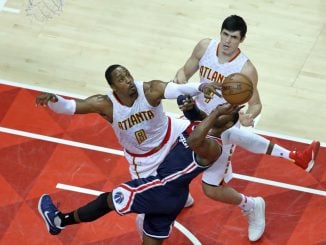
Luck was on the Charlotte Hornets’ side last May when the team jumped from the No. 8 spot to earn the third overall pick in the 2020 NBA Draft Lottery. And it just so turned out that last year’s draft had three players who were considerations for the first overall pick: LaMelo Ball, Anthony Edwards and James Wiseman.
Charlotte knew they were getting one of them, but Minnesota and Golden State — who held the first and second pick, respectively — would be the teams deciding who would be left when the Hornets picked third.
Enter Lady Luck again.
The Timberwolves made Edwards the first overall pick, and then the Warriors chose Wiseman at No. 2. That left Ball for Charlotte at No. 3.
Thirteen months after the Hornets had the youngest Ball brother fall into their lap, the 6-foot-6 point guard became the third player in franchise history to be named rookie of the year and is now the presumed centerpiece of a franchise that has been spinning its wheels for most of its existence.
Ball missed 21 games of his first season with a broken wrist, but he was still the runaway winner for the award. Ball received 84 first-place votes, easily outdistancing Edwards (15 first-place votes) to join Emeka Okafor (2005) and Larry Johnson (1992) as the only Charlotte players to be named the league’s top rookie.
His numbers in his first season mirror that of another point guard with North Carolina ties — 2006 Rookie of the Year Chris Paul. Ball averaged 15.7 points, 5.9 rebounds and 6.1 assists in 51 games in 2020-21. In 78 games, Paul — then playing for the Hornets when the team was in New Orleans and Oklahoma City — averaged 16.1 points, 5.1 rebounds and 7.8 assists in his first NBA season.
We all know how things worked out for the 36-year-old Paul, who is currently playing with the Suns in the Western Conference Finals and is on his way to the Hall of Fame whenever he decides to hang up his signature CP3s.
But what is the track record of other rookie of the year winners?
Twenty-seven players in ABA and NBA history went from being named rookie of the year to being inducted into the Naismith Memorial Basketball Hall of Fame. Just three of them are point guards: Oscar Robertson (1961), Jason Kidd (1995) and Allen Iverson (1997). Kidd shared the rookie of the year honors with Grant Hill during their rookie season.
By the time Paul’s third season came around, he was leading the league in assists and it was pretty clear he was the real deal. Robertson, who led the league in assists as a rookie, did it again in Year 2 and averaged a triple-double for the second straight year. Kidd was No. 2 in assists in his second season, trailing only John Stockton that year. And by his third season, Iverson — more of a scorer than most traditional point guards — led the league in scoring.
But for every top rookie point guard-turned-Hall of Famer, there is a Steve Francis, Derrick Rose or Ben Simmons who struggled to reach that next level, be it because of limitations in their game, injuries or failure to step up in big games.
The next step for Ball will be proving he has that next gear to join the league’s elite and become a player the Hornets can plan their entire future around.
Ball has already shown he can score, pass and rebound, but he’ll need to get bigger and stronger to handle the rigors of being the opposition’s focal point night after night.
Ball made strides as a defender and will benefit from maturing physically, but there are still rough edges that need polishing for him to become a complete player.
And while Ball silenced those who criticized his unorthodox shot release, making 35.2% from 3-point range, he’ll need to become a more consistent jump shooter to be a real threat as a scorer. Ball had 13 games in which he missed all his 3-point attempts and 11 more games in which he made only a quarter or fewer of his shots from long range. He also made just 25.5% of his 3-pointers after returning from his wrist injury.
Charlotte and Ball should also get some help in the draft with the 11th overall pick, and the biggest need is at center. Turkey’s Alperen Sengun or Kai Jones from the University of Texas could be options, but chances are Mitch Kupchak will take the best available player or wheel and deal to fill the team’s needs.
Who knows? Maybe the Hornets will get lucky again.




